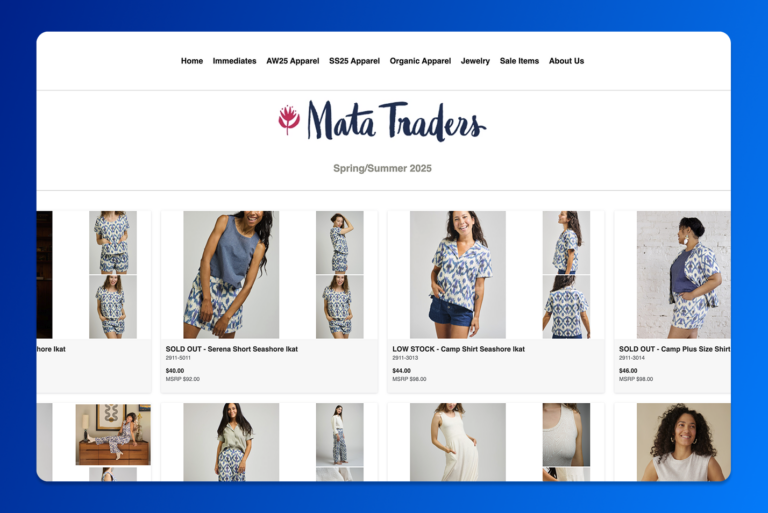In the fashion world, where trends change with the seasons and consumer demands are as diverse as the fabrics they adorn, the apparel industry faces a unique set of challenges. With global revenue that reached 1.5 trillion U.S. dollars in 2021 and is projected to climb to 2 trillion by 2026, the industry’s growth is nothing short of phenomenal. But with growth comes complexity, and managing the multifaceted operations of design, manufacturing, distribution, and customer engagement becomes a Herculean task.
Enter enterprise resource planning (ERP), a technological marvel that promises to weave efficiency into the very fabric of the apparel industry. From the looms of manufacturing to the glitz of retail, enterprise resource planning systems are set to redefine how the industry operates, offering streamlined processes, cost reductions, and enhanced collaborations. It’s not just about connecting dots; it’s about creating a seamless tapestry that resonates with the dynamic nature of fashion.
As we stand on the cusp of a new era where technology meets creativity, integrating an automated ERP business process in the apparel industry is more than a trend; it’s a strategic move toward innovation, sustainability, and growth.
Join us as we unravel the six ways enterprise resource planning is revolutionizing the apparel industry, offering a wide range of features, and stitching together a future that’s not just stylish but smart.
Streamlined Supply Chain Management
In the apparel industry, managing the supply chain is a complex task encompassing design, production, distribution, and retail. The ability to optimize and efficiently handle supply chains is vital for expansion and growth.
And as business models such as e-commerce become more popular, having a tool that allows you to keep track of your products ideation, manufacturing, and completion process is a serious competitive advantage.
Here’s how enterprise resource planning systems act as the single source of truth and centralize and integrate functions, leading to a streamlined supply chain:
1. Enhanced Visibility Across the Supply Chain
ERP software enables clear insights into back-end operations, a crucial aspect for assessing risks and strategizing for upcoming opportunities. It allows for real-time tracking of materials, production, and distribution, enabling the detection of production shortfalls and their rectification before they escalate into problems.
This visibility extends to raw materials, quality checks, and the impact of delays on production.
2. Collaboration and Accuracy
By unlocking a complete overview of the supply chain and engaging with vendors with the help of ERP business process automation, businesses can be completely involved in core business processes and know how each operation transpires.
From raw materials to finished clothing, manufacturers, designers, distributors, and retailers have the ability to monitor the complete supply chain. This collaboration increases accuracy and reduces errors in processes like ordering, enhancing customer satisfaction.
3. Sustainability and Ethical Practices
Transparent overview of the supply chain allows brands to ensure that sustainable workflows are followed. Enterprise resource planning systems can provide transparency on how garments are produced and also information about the labor force and offer insights on how to minimize the wastage of materials.
This alignment with sustainability is increasingly important to consumers and represents an investment in the future.
4. Demand Forecasting and Inventory Management
Enterprise resource planning systems play a crucial role in demand forecasting, identifying demand for certain set periods, and aligning operations such as materials planning and inventory. This optimization supports apparel supply chain management by balancing stock levels, production capacity, and resource needs. Real-time inventory management capabilities prevent supply chain issues, avoiding delays or losing customers.
5. Up-Time and Predictive Maintenance
For apparel manufacturers, enterprise resource planning systems offer predictive maintenance to avoid machinery problems and hold-ups in the supply chain. Monitoring production throughput in real time is vital for assessing performance and sustaining a competitive edge in pricing. It allows for continuous monitoring of production, ensuring that any setbacks are quickly identified and addressed.
Enhanced Collaboration and Communication
Enterprise resource planning systems facilitate seamless communication across departments, suppliers, and retailers in the apparel industry. This improved data exchange means decision-makers can make timely business processes and adequate decisions, which is vital for the fast-paced apparel industry, where trends change rapidly.
The ability to share information in real time is paramount. Leveraging an ERP business process helps in this area by providing real-time insights about materials, inventory, sales, and more. This immediacy in information sharing not only fosters better relationships with customers and suppliers but also enhances employee satisfaction. By creating a more transparent and cohesive work environment, ERP encourages collaboration and drives better ways to achieve collective goals. Team efforts are aligned and amplified, leading to more efficient and effective processes.
Building on this foundation of real-time information, ERP systems also offer robust data analytics capabilities. By providing accurate data and meaningful insights, these systems help businesses understand, interpret, and predict changing consumer demands. This predictive power is more than just a strategic advantage; it’s a tool for enhancing the entire customer experience. By anticipating customer needs and preferences, businesses can create more personalized and engaging interactions. This not only attracts new customers but also strengthens loyalty among existing ones, fostering a growth-oriented environment that resonates with the modern consumer’s expectations.
Together, real-time information sharing and data analytics form a powerful combination within ERP systems. They bridge the gap between day-to-day operations and long-term strategy, promoting a more responsive, customer-centric approach that adapts to market trends and positions businesses for success in a competitive landscape.
Centralized Business Processes for Faster Processes
From design to distribution, ERP centralizes all business functions in the apparel industry. Standardized business practices mean quicker invoicing, consistent quality control, and efficient daily operations. This is particularly beneficial for managing various clothing lines and collections.
- Simplified processing of returns and orders: ERP software manages and tracks returns and orders, facilitating better on-time deliveries and enhanced return management.
- Role-based permissions: ERP enables businesses to create role-based permissions, facilitating control over information access and ensuring that only the right employees have access.

ERP for Business and Inventory Management Tailored to Apparel Needs
The ERP business process is streamlined and gives business owners a comprehensive look into inventory, aligning product availability with current and future customer needs. It helps in tracking seasonal demands, reducing overstocking, and ensuring that the right products are available at the right time.
Enterprise resource planning systems serve as vital tools for businesses looking to gain better control over their inventory. Through the use of advanced algorithms and tracking mechanisms, enterprise resource planning offers robust capabilities to monitor both surpluses and shortages.
Unlike manual processes and methods, which can be prone to errors and inefficiencies, Enterprise resource planning systems’ automated inventory management keeps track of stock levels with precision and speed. This heightened oversight not only minimizes waste but also ensures that products are available when and where they’re needed. In a marketplace where timely delivery can make or break a customer relationship, the improved efficiency offered by enterprise resource planning can be a game-changer with its features and deployment options.
But the advantages of enterprise resource planning go beyond just inventory management. Successful implementation of this technology is a strategic investment that requires careful consideration of cost and potential returns. While the initial outlay for enterprise resource planning systems can be significant, the long-term benefits can more than justify the expense. Particularly in areas like inventory management, the automation and optimization provided by enterprise resource planning can lead to substantial cost savings.
Over time, these savings can translate into tangible returns on investment, making the adoption of enterprise resource planning systems not just a cost of doing business but a pathway to greater profitability and success.
Together, these aspects of enterprise resource planning systems—the granular oversight of inventory and the thoughtful consideration of costs and investments—contribute to a comprehensive solution that can transform the way a business operates. By leveraging these tools, companies can position themselves to be more agile, responsive, and competitive in today’s ever-evolving marketplace.
Improved Customer Relationship Management (CRM)
ERP’s integration with CRM gives a unified view of customer interactions. In the apparel industry, understanding customer preferences and buying patterns is key. ERP helps target communications and offers based on customer behavior, enhancing the shopping experience.
- Enhanced customer service: Customers benefit from good-quality products at reduced prices thanks to ERP’s ability to streamline operations.
- Scalability considerations: ERP software consists of different modules that can be scaled to meet the growth of the business, ensuring that customer relationship management remains effective.
Besides that integration, the best ERP systems can integrate with third-party accounting software to extend the functionality of their ERP systems and enjoy operating in a more informed manner regarding their finances.
Adaptation to Fashion Trends with Reduced IT Costs
The apparel industry is characterized by dynamic and ever-changing fashion trends, requiring businesses to constantly adapt and evolve. Enterprise resource planning systems play a vital role in meeting these demands, as they reduce the need for multiple, separate programs for different functions within the company. By consolidating these functions into a single, unified system, businesses can react more swiftly to market changes without incurring significant IT costs.
Ease of operations is another crucial benefit offered by enterprise resource planning systems. By bringing all relevant data onto one platform, information becomes more accessible and manageable. This integration not only simplifies the daily workflow but also enhances decision-making by providing a comprehensive view of the entire business. Managing inventory, overseeing sales, or studying consumer patterns becomes more efficient with an ERP system, as it simplifies and enhances these processes. The choice of the appropriate ERP software from among the leading providers is a crucial decision that calls for thoughtful analysis and evaluation.
Factors such as cost, scalability, and the specific needs and requirements of the business must be evaluated.
Some businesses may prioritize customization, software application integrability, and flexibility, while others might focus on user-friendliness and support. The choice of ERP software must align with the long-term goals and operational needs of the company. A choice such as Apparel Magic’s cloud ERP solution can deliver on all of the fields we’ve discussed above, enabling business owners to focus on crucial tasks and let a tool designed by experts handle the backend.
With a robust cloud-based ERP system, businesses won’t need an on-premises solution to optimize their entire supply chain and ensure excellence in inventory management and customer relationships.
Conclusion
In the rapidly evolving and highly competitive landscape of the apparel industry, enterprise resource planning systems emerge as an essential thread and an alternative to outdated processes in the intricate tapestry of the fashion industry. With a suite of capabilities that span streamlined supply chain management, enhanced collaboration, centralized business functions, tailored inventory management, improved customer relationship management, and adaptation to ever-changing fashion trends, ERP is far more than a technological tool—it’s a transformative strategy.
The revolution ushered in by ERP is not just about keeping pace with trends but leading the way in an industry where style meets substance and creativity aligns with technology. It’s a new era in the fashion industry that is not just about being chic but also about being intelligent and responsible, thanks to ERP and its ability to improve business activity and operation.







